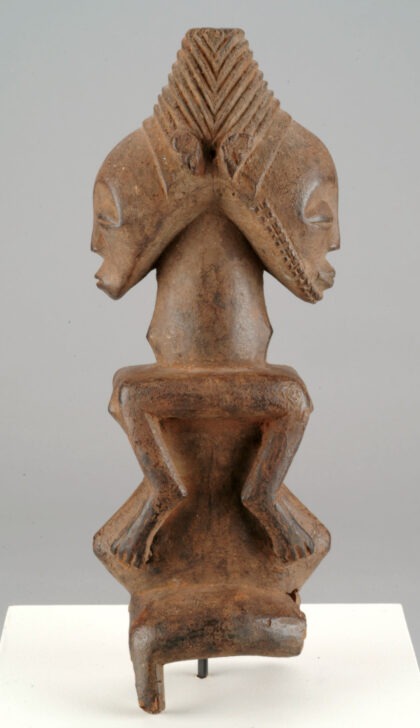Power Figure
Hemba

Description
Subject Matter:
Known as kabeja, this double-faced power figure is a representational form prevalent among the Hemba from the Democratic Republic of the Congo. Stylistically, this particular specimen comes either from the northern Hemba area or the Hemba-Niembo region.
According to Hemba cosmology, the kabeja evokes the legend surrounding the primordial couple who gave birth to a malformed infant having two heads, four arms, and four legs. Unable to keep the child, the couple sacrificed the infant, and in order to prevent this from happening to future offspring, the infant was elevated to the rank of an esteemed spirit. Henceforth, in order to avoid misfortune, the infant’s spirit must be appeased and venerated by the community.
The kabeja were used in ancestral and fertility rites because they simultaneously evoked male and female ancestors. Thus, the kabeja’s inherently bivalent nature was seen to promote equilibrium and harmony--between men and women, and the living and the dead. The chief of a clan or lineage was responsible for activating and safeguarding kabeja figures.
Here, the kabeja bears a cavity at the center of the head for the placement of medicinal-symbolic substances, endowing the figure with power. The fontanelle is especially significant for it is the site where communication with spirits take place. The patina on the kabeja’s surface are the remains of sacrificial and votive offerings, reflecting the dynamic use and potent efficacy of the figure.
Reference:
Maurer, Evan M. and Niangi Batulukisi. Spirits Embodied: Art of the Congo, Selections from the Helmut F. Stern Collection. Minneapolis: The Minneapolis Institute of Arts, 1999.
Physical Description:
This double-faced sculpture has been carved from semihard wood. The male is distinguished by the beard, formed by a double row of small triangles. The female, which faces the opposite direction, shares a neck and trunk with her male counterpart. The heads are disproportionately large and both faces are ovoid-shaped, with a wide convex forehead and broad features. Their coiffures converge to form a single cone composed by stratified, semi-circular rings. A cavity on the top of the coiffure likely held medicinal substances, imbuing the figure with power. The male and female each have sharply protruding bellies, marked with round umbilici. Both possess two sets of arms, which are detached from the body and situated on either side of their respective abdomens. Three of the four feet have broken off. The encrusted surface of the kabeja reveals that it was once the recipient of libational offerings.
Usage Rights:
If you are interested in using an image for a publication, please visit https://umma.umich.edu/request-image/ for more information and to fill out the online Image Rights and Reproductions Request Form.